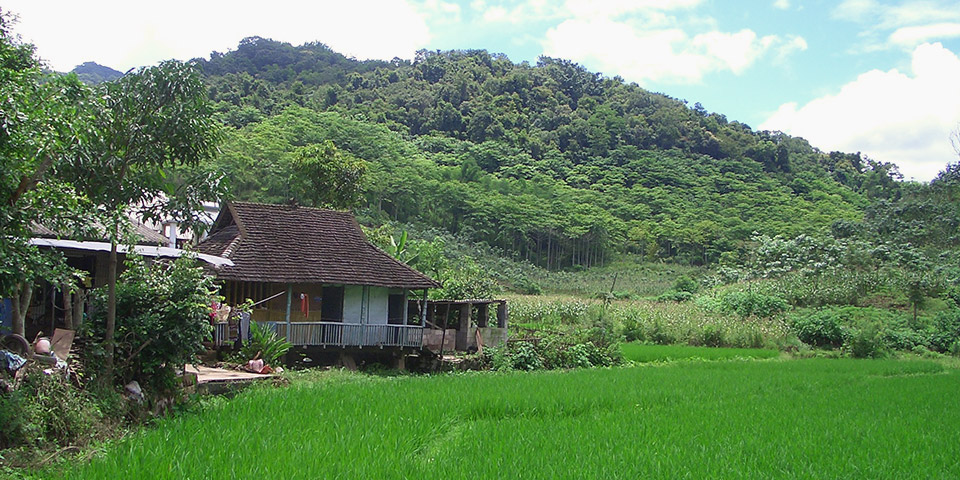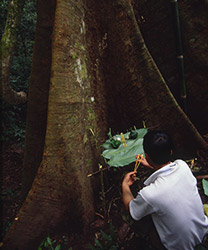సైట్ యునాన్ ప్రావిన్స్లోని పవిత్ర కొండలకు దక్షిణం వైపున జిషువాంగ్బన్నా డై అటానమస్ ప్రిఫెక్చర్ ఉంది., యునెస్కో మ్యాన్ అండ్ బయోస్పియర్ రిజర్వ్గా గుర్తింపు పొందింది. కంటే తక్కువ కవర్ అయినప్పటికీ 0.2 చైనా మొత్తం భూ ఉపరితలంలో శాతం, ఇది గురించి కలిగి ఉంటుంది 20 దేశాలలో శాతం నమోదు చేయబడిన జాతులు, ఇది దేశంలోనే జీవవైవిధ్యానికి అత్యంత ధనిక ప్రాంతంగా మారింది. ఇది యునాన్ యొక్క పదమూడు జాతి సమూహాలకు కూడా ఆతిథ్యం ఇస్తుంది, ప్రధానంగా ఉష్ణమండల మరియు ఉపఉష్ణమండల ప్రధాన భూభాగ ప్రాంతాల్లో నివసిస్తున్నారు. గత కొన్ని సంవత్సరాలుగా, ఆర్థిక మరియు జనాభా వృద్ధి ద్వారా ఎదురయ్యే బెదిరింపులను వ్యతిరేకించడానికి నిల్వలు స్థాపించబడ్డాయి.
బెదిరింపులు చివరిలో 50 సంవత్సరాల, 90 శాతం 750 హోలీ హిల్ అడవులు నాశనం చేయబడ్డాయి లేదా క్షీణించబడ్డాయి. వేగవంతమైన ఆర్థికాభివృద్ధి మరియు జనాభా పెరుగుదల విపరీతమైన భూ వినియోగ ఒత్తిళ్లను కలిగించడం ఈ నష్టానికి ఒక కారణం, దీనివల్ల ఈ అడవులు ప్రధానంగా రబ్బరు తోటల ద్వారా భర్తీ చేయబడతాయి. అదనంగా, కమ్యూనిటీ నిర్వహణ నుండి అటవీ భూమి నిర్వహణ విధానం మారింది (1980యొక్క) వ్యక్తిగత నిర్వహణకు (2000యొక్క), ఇది గ్రామస్తులకు వారి వ్యక్తిగత అటవీ భూములను ఇతరులకు లీజుకు ఇచ్చే అవకాశాన్ని సృష్టించింది.
చెట్లన్నీ నరికితే, మీకు తినడానికి బెరడు మాత్రమే ఉంది; మీరు అడవిని నాశనం చేస్తే, మీరు భవిష్యత్తుకు మీ మార్గాన్ని నాశనం చేస్తారు - యునాన్ ప్రావిన్స్ నుండి డై ఫోక్సాంగ్, చైనా (వాంగ్ 1988)
సంరక్షకులు సుమారు తో 35% Xishuangbanna జనాభాలో, డై ప్రిఫెక్చర్లో అత్యంత సమృద్ధిగా ఉన్న జాతి సమూహం. ఆహార పదార్ధాలు మరియు నీటి సరఫరా కోసం వారు స్థానిక అడవులపై ఆధారపడతారు. పవిత్ర కొండలపై కొన్ని పవిత్రమైన అడవులు ఉన్నాయని వారు నమ్ముతారు (నాంగ్) దేవతల నివాసం. ఈ అడవులలో నివసించే మొక్కలు మరియు జంతువులు వారి సహచరులు, మరణించిన పూర్వీకుల ఆత్మలతో పాటు వారి మరణం తర్వాత ఈ అడవులకు తరలిస్తారు. ఈ అడవులలో మొక్కలు మరియు జంతువులపై హింస లేదా భంగం కలిగించడం దేవతలచే శిక్షించబడుతుంది మరియు కొన్ని సమాజాలలో ఖచ్చితంగా నిషేధించబడింది. దాదాపు వరకు 50 సంవత్సరాల క్రితం, ఈ అడవులు ఆధ్యాత్మిక అధిపతి నేతృత్వంలోని సాంప్రదాయ సంస్థలచే రక్షించబడ్డాయి (సూప్) స్థానిక గ్రామం. దై నిజానికి యానిమిస్ట్ సంప్రదాయాన్ని అనుసరించింది, ఇది సహజ ప్రపంచానికి భారీగా కట్టుబడి ఉంది, మరియు అటవీ ఆధారిత తత్వశాస్త్రం కలిగి ఉన్నారు. దై అవగాహనలో మానవులు మరియు వారి భౌతిక వాతావరణం మధ్య పరస్పర సంబంధం ఐదు ప్రధాన అంశాలను కలిగి ఉంటుంది: అడవి, నీరు, భూమి, ఆహారం మరియు మానవత్వం. అడవి మానవుల ఊయలని వారు నమ్ముతారు. అడవుల నుంచి నీరు వస్తుంది, భూమి నీటితో పోషణ పొందుతుంది మరియు భూమి నుండి ఆహారం వస్తుంది. అడవులు అంతిమంగా మానవ జీవితానికి మద్దతు ఇస్తాయి మరియు ఈ అడవులు అతీంద్రియ రాజ్యంతో ఒకటి.
సంకీర్ణ రిజర్వ్ మేనేజర్లు మరియు స్థానిక గ్రామ సంరక్షకులు భాగస్వామ్య నిర్వహణ విధానాలను ఉపయోగించి నిల్వలను సంయుక్తంగా నిర్వహిస్తారు. పవిత్ర వనంపై కమ్యూనిటీ నిబంధనలు మరియు సాంప్రదాయ ఆచారం మరియు పూజా కార్యక్రమాలు గ్రామస్తుల ఆసక్తికి అనుగుణంగా నిర్వహించబడతాయి మరియు అమలు చేయబడతాయి.
పరిరక్షణ పరికరములు ఎక్కడ ఆధునికత ఒత్తిళ్లను తట్టుకుని నిలబడ్డారు, పవిత్రమైన సహజ ప్రదేశాలు స్థానిక సంస్కృతులు మరియు సాంప్రదాయ విశ్వాస వ్యవస్థలలో బాగా పొందుపరచబడ్డాయి. చెట్లను నరికితే USD జరిమానా విధించబడుతుంది 20-40 చెట్టుకు. పెద్ద స్థాయిలో, ప్రకృతి నిల్వలు, బఫర్ జోన్లు మరియు బయో-కారిడార్లు యునాన్లోని జీవవైవిధ్య ప్రదేశాల పరిరక్షణకు ప్రధాన వ్యూహం.. పవిత్రమైన సహజ ప్రదేశాలను కాపాడేవారు చట్టబద్ధంగా రక్షిత జీవసంబంధమైన సైట్ల నెట్వర్క్లో తమ సైట్ను చేర్చాలని వాదిస్తూ ఉంటారు..
విజన్ భవిష్యత్తులో, క్షీణించిన పవిత్ర అడవులను పునరుద్ధరించడం ద్వారా పవిత్ర కొండలను మళ్లీ పవిత్రం చేయవచ్చు. జిషువాంగ్బన్నాలోని రక్షిత ప్రాంతాల మధ్య అటవీ కారిడార్లలో వాటిని చేర్చాలని సిఫార్సు చేయబడింది. పవిత్రమైన అడవుల సామాజిక మరియు పరిరక్షణ విలువను గుర్తించడానికి విధాన మద్దతు అవసరం. ఇది రక్షిత నిబంధనలను ఏర్పాటు చేయడానికి సహాయపడుతుంది, గ్వాంగ్డాంగ్ ప్రావిన్స్లో గతంలో చేసినట్లు. ఈ ప్రాంతం యొక్క మరింత అభివృద్ధిలో, సాంప్రదాయ జ్ఞానాన్ని ఉపయోగించడం వల్ల పర్యావరణ అనుకూలమైన పాలనను సులభతరం చేయవచ్చు.
యాక్షన్ Xishuangbanna లో పవిత్ర అడవులు నాటకీయంగా నష్టపోయినప్పటికీ, సాంప్రదాయ సంస్కృతి పునరుద్ధరించబడింది, మరియు మిగిలిన అడవులలో కొనసాగుతుంది. ప్రతి సంవత్సరం ఆగస్టు మరియు నవంబర్లలో పూజా కార్యక్రమాలు నిర్వహిస్తారు మరియు గ్రామంలోని సభ్యులందరూ పాల్గొంటారు, ఆహార సమర్పణలు, కోళ్లు మరియు పందులను తయారు చేస్తారు. అదనంగా, స్వదేశీ స్థానికులు మరియు బాహ్య మద్దతుదారులు ఈ ప్రాంతంలో ప్రకృతి నిల్వల ఏర్పాటు కోసం వాదించారు.
విధానం మరియు చట్టంపై పవిత్రమైన సహజ ప్రదేశాలు చట్టం ద్వారా గుర్తించబడవు. ఏదైనా ఉంటే, శాసన మార్పులు గత దశాబ్దంలో వారి అధోకరణాన్ని సులభతరం చేశాయి. అయితే అవి తరచుగా అనేక రక్షిత జాతులను కలిగి ఉంటాయి, వాటిని జీవవైవిధ్య హాట్స్పాట్లుగా గుర్తించే అవకాశం ఉంది. ఇది నిజంగానే జరుగుతోంది.
ఫలితాలు రిజర్వ్లోని నాలుగు గ్రామాల ప్రజలతో ముఖాముఖి ప్రకారం, చెట్ల నరికివేత కేసులు లేవు, గతంలో పవిత్రమైన అటవీ ప్రాంతంలో వేటాడటం లేదా అధికంగా పండించడం జరిగింది 20 సంవత్సరాల. రిజర్వ్లో పవిత్రమైన అటవీ నిర్వహణలో సమాజ భాగస్వామ్యం సమర్థవంతంగా మరియు విజయవంతమైందని ఇది చూపిస్తుంది. యున్నిన్లో పవిత్రమైన సహజ ప్రదేశ పరిరక్షణకు కొన్ని నిల్వల ఏర్పాటు ప్రధాన అడుగు, కానీ మరింత రక్షణ కావాల్సినది.
- షెంగ్జీ, పి, (2010) ది రోడ్ టు ది ఫ్యూచర్? యునాన్ ప్రావిన్స్లోని హోలీ హిల్ అడవుల బయోకల్చరల్ విలువలు, చైనా, వెర్స్చురెన్లో, వైల్డ్, మెక్నీలీ, ఒవిడో (2010) పవిత్రమైన సహజ సైట్లు: ప్రకృతి మరియు సంస్కృతి యొక్క పరిరక్షించటం, భూమి స్కాన్, లండన్.
- పీ ఎస్.జె., 2006: జిషువాంగ్బన్నా బయోస్పియర్ రిజర్వ్ యొక్క పవిత్ర అడవులలో జీవవైవిధ్యం, చైనా, యునెస్కోలో ప్రచురించబడింది 2006 (లీ మరియు షాఫ్). టోక్యో సింపోజియం యొక్క ప్రొసీడింగ్స్: సాంస్కృతిక మరియు జీవవైవిధ్యంపై పరిరక్షణపై, పవిత్ర సహజ ప్రదేశాలు మరియు సాంస్కృతిక ప్రకృతి దృశ్యాల పాత్ర, యునెస్కో, పారిస్.
- పీ ఎస్.జె. 1993: టెంపుల్ యార్డ్స్ మరియు హోలీ హిల్స్లో బయోలాజికల్ డైవర్సిటీ నిర్వహణ: Xishuangbannan డై కమ్యూనిటీ యొక్క సాంప్రదాయ పద్ధతులు, నైరుతి చైనా, హామిల్టన్లో, ఎల్.ఎస్. (ed.) నీతిశాస్త్రం, మతం మరియు జీవవైవిధ్యం,, వైట్ హార్స్ ప్రెస్. కేంబ్రిడ్జ్ UK.
- జీవవైవిధ్యం మరియు దేశీయ విజ్ఞాన కేంద్రం (CBIK) వద్ద www.cbik.org
- జెంగ్, L. (2012) జిషువాంగ్బన్నాలోని డై ప్రజలలో సాంస్కృతిక పరివర్తన మరియు పర్యావరణ స్థిరత్వం, నుండి అందుబాటులో: www.sustainablechina.info





